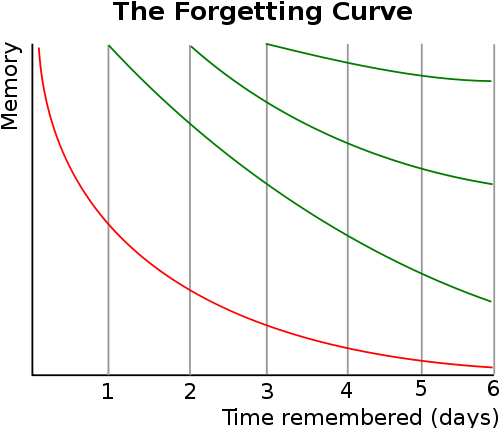Editor’s note: We’re still waiting on the author’s brain to return from Asia. It’s on the slow boat but it should arrive any day now. Until then, we have to work with what we’ve got.

As a musician, I need to remember a staggering amount of information: songs, chord changes, lyrics, leads, etc. In a short-term project, this is easy enough: practice a bunch of songs, perform them, and go on to the next thing.
However, a few months ago, I realized I had a problem: I’d forgotten more songs than I could count. I would learn a song, play it a few times, then forget about it. When I wanted to play it months later, I really had forgotten about it; I had to go back and relearn the damn thing.
After a little research, I discovered my problem: I didn’t have a system in place for reviewing material I had already learned. Sure, it’s easy enough to relearn a song I’ve learned in the past, but this is luxuriously inefficient use of my limited practice time. In short, I was cramming when I should’ve been spacing.
What is Spacing?
Spacing isn’t the thing you do at a party after you’ve had too much (insert your favorite poison here). Spacing is a creative technique that involves reviewing new material at set intervals of time.
In 1886, German scientist Hermann Ebbinghaus proved that cramming sucks when he published Memory: A Contribution to Experimental Psychology. In this work, he identified the spacing effect. The spacing effect states that people remember best when they study new information a little bit over a long period of time. Before we look at remembering, we need to see how people go about forgetting.
The graph below (courtesy of Wikipedia user Icez ) shows the standard forgetting curve. The red line represents information learned once and never reviewed: an exponential decrease. The green lines show forgetting curves if you review on day one, two, and three. Note day three: the drop is far less severe; we can assume that the information will drop far slower and will be far easier to recall over the next several weeks.

As sharp as the red curve is, it’s obvious that learning something once (cramming) is rarely enough. Even with a bagful of mnemonic and associative tricks, some things simply have to be reviewed. This brings up a new question, then: At what interval do you review?
First, let’s assume we don’t need to review everyday. According to research from Hal Pashler et al, increasing the interval between reviews actually resulted in better retention. In other words, reviewing weekly is less effective than reviewing at one week, then one month, then three months. So, to retain new information, we need to spread review sessions out. What are the ideal intervals for retaining new information?
1 hour, 1 day, 1 week, 1 month, 3 months, 6 months, 1 year.
These review intervals take advantage of Ebbinghaus’ spacing effect and Pashler’s research on efficient review and retention. But there’s still one more problem: remembering to review.
How to Remember to Review
Google might one day turn us all into cold cyborgs connected to a collective command-and-control system, but Gmail and Google Calendar are excellent tools for spaced reviews. Here’s my setup.
When I learn a new (song, since that’s the example I’m using), I’ll go into Google Calendar and create an Event using the above interval schedule (1,1,1,1,3,6,1). Each event includes a reminder sent to my inbox that says ‘time to review XX song.’ Set it up and forget about it…until review day.
Low-tech solutions are easy enough to implement: you can simply pencil in review dates on your paper wall calendar. Obviously this works best if you check your calendar most days.
High or low tech, once you decide on a system, you can tweak the dates to accommodate your schedule. For me, I spend about one day a month reviewing things I learned over three months ago.
Reviewing old material might take a little extra time and effort, but it’s worth it. If you can’t remember what you’ve learned, what’s the point of learning it in the first place?
If you enjoyed this fine post, join Happenchance on Facebook, subscribe to Happenchance for more creative techniques, or hit one of the fancy social media buttons below to share it with your frienemies.
Photo credit: arboghast

Comments on this entry are closed.
SETH,
I need this. I hope I can put it into practice. Thanks!!!!
Franklin
There are a few software packages that can algorithmically determine the optimum spacing for you: SuperMemo or open source alternatives Mnemosyne and Anki.
There is a Wired article that covers the technique quite well:
Want to Remember Everything You’ll Ever Learn? Surrender to This Algorithm
The software tends to be aimed more towards memorising vast amounts of vocabulary and/or rote facts, but i’m sure you could come up with a system for music pieces. The main benefit over your current system would be increased efficiency, you wouldn’t have to manually setup reminders and the spacing would likely be further apart.
This post takes the site motto “useful stuff for creative people” to a new level. This might be your most widely applicable post yet. I enjoyed it. Well done.